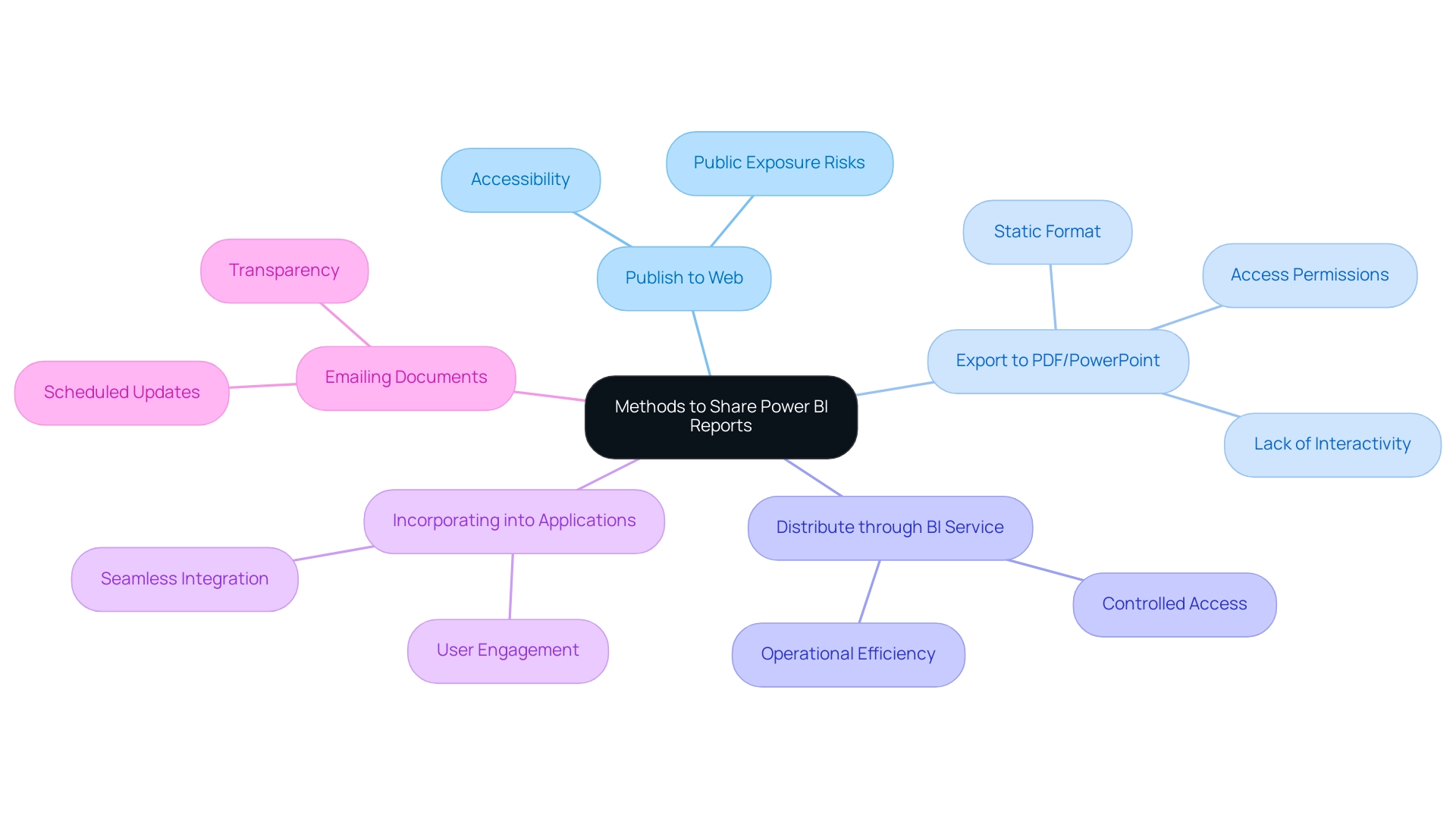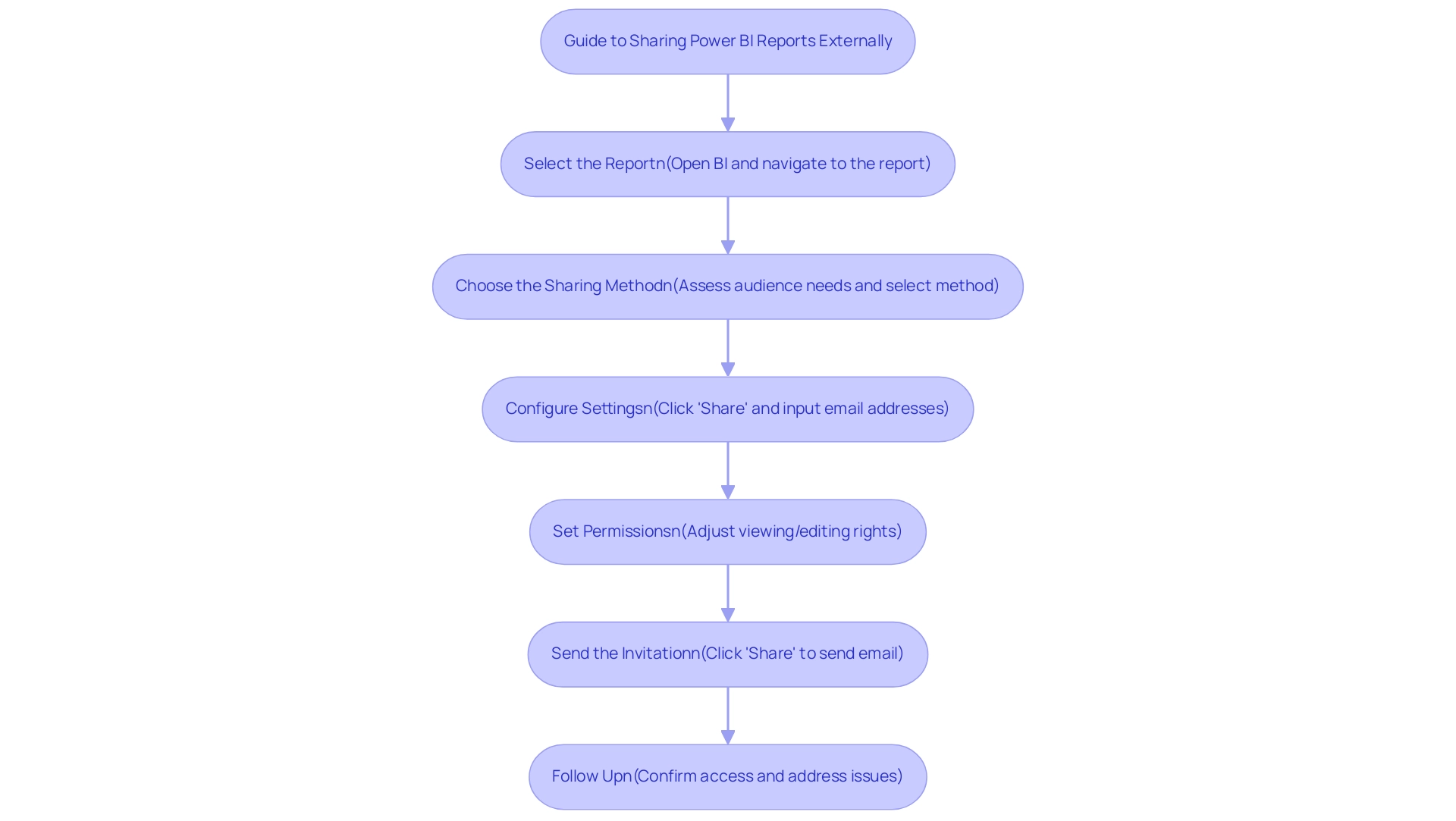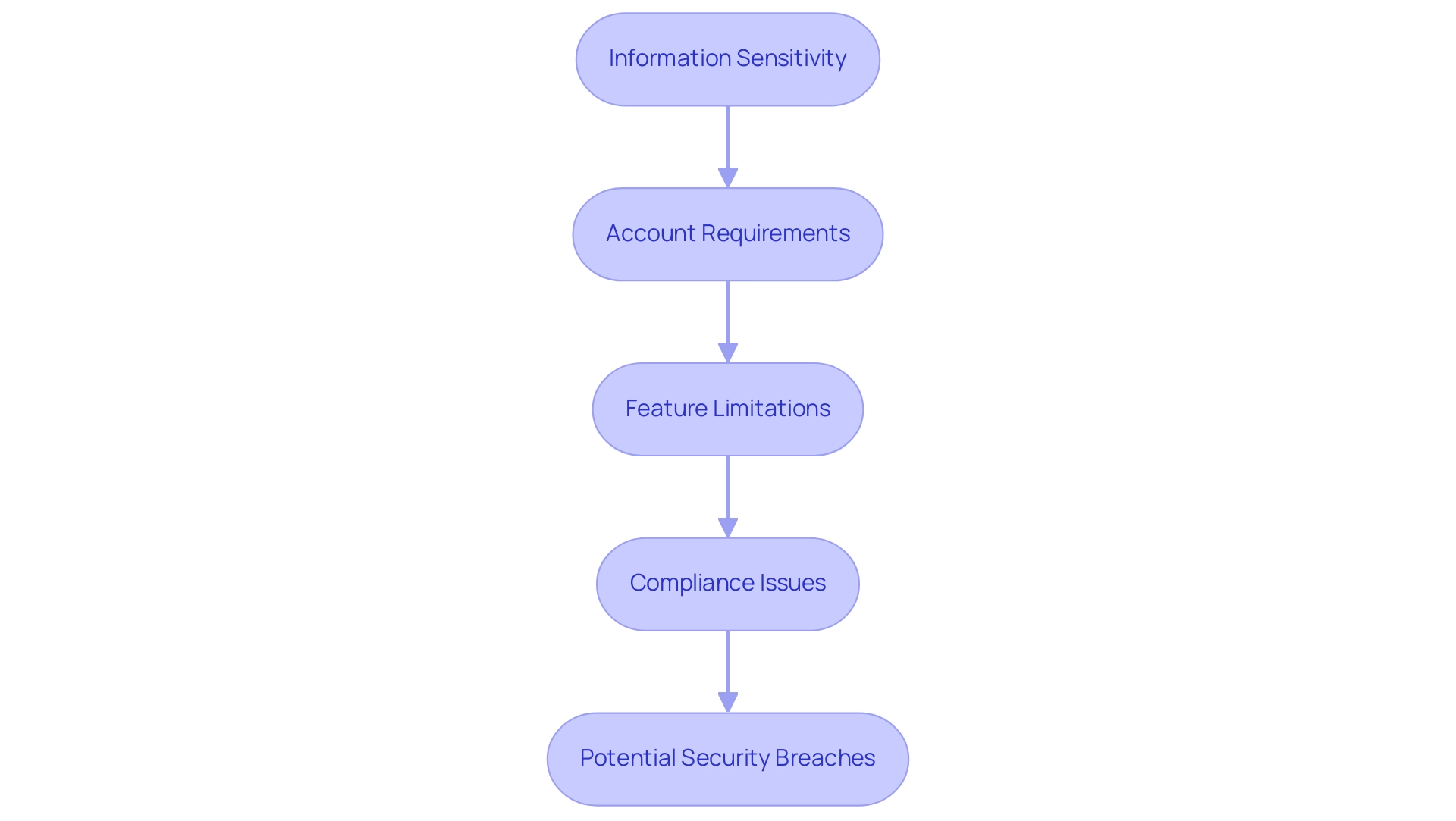Overview
To share Power BI reports outside your organization, several methods are available, including using the “Publish to Web” feature, exporting to PDF or PowerPoint, and sharing directly via the BI Service. Each method has unique considerations regarding security, interactivity, and audience needs, which are crucial for ensuring effective collaboration while protecting sensitive information.
Introduction
In the realm of data-driven decision-making, sharing insights from Power BI reports can be a game-changer for organizations seeking to enhance collaboration and transparency. With a myriad of methods available, from public links to secure email updates, each approach presents unique advantages and considerations that can significantly impact how data is utilized.
As businesses navigate the complexities of external sharing, understanding the nuances of permissions, roles, and best practices becomes essential. This article delves into effective strategies for sharing Power BI reports, empowering organizations to overcome common challenges while ensuring data security and fostering informed decision-making.
By exploring practical solutions and real-world examples, leaders can unlock the full potential of their data, driving growth and innovation in an increasingly competitive landscape.
Exploring Different Methods to Share Power BI Reports
There are various methods on how to share Power BI report outside organization, each tailored to different needs and scenarios. Here’s a breakdown of the primary options available:
-
Publish to Web: This feature enables you to create a public link to your document, making it accessible to anyone.
While convenient, it’s crucial to be mindful that this method exposes your information to the public, which may not be suitable for sensitive content. -
Export to PDF or PowerPoint: Exporting your document to PDF or PowerPoint format is an effective way to share static formats.
However, this option lacks interactivity, limiting engagement with the data. It’s essential to recognize that individuals require access to the document to see it within the presentation software, and the same permissions apply as in Business Intelligence. -
Distribute through BI Service: For individuals who utilize BI, insights can be shared directly through the BI platform.
By including individuals or groups, you retain authority over who views the documents, ensuring that sensitive information stays secure. This method enhances operational efficiency by streamlining how data-driven decisions are made within your organization. -
Incorporating into Applications: Organizations can improve experience by integrating BI insights directly into custom applications utilizing the BI API.
This seamless integration enables individuals to engage with documents within familiar interfaces, fostering involvement and actionable insights without the necessity for additional navigation. -
Emailing Documents: The ‘Subscribe’ feature enables scheduled email updates of your documents to external users with Business Intelligence accounts.
This approach is beneficial for keeping stakeholders updated without needing them to access the BI service, thus fostering a culture of transparency and ongoing information sharing.
Each sharing method has unique use cases and considerations. For example, using BI shared datasets can centralize your data model for various documents, enhancing consistency and diminishing redundancy—crucial elements in addressing issues such as data inconsistencies and time-consuming document creation.
Moreover, by effectively addressing these challenges, organizations can leverage insights from BI dashboards to drive growth and innovation.
A pertinent case study is the creation and sharing of applications in BI, which enables report designers to share collections of reports and dashboards with specific user groups while maintaining control over the content.
As Grant Gamble, proprietor of G Com Solutions, highlights, “I operate a firm named G Com Solutions, focusing on BI training and consultancy, assisting businesses in mastering analytics.”
This mastery can significantly impact how effectively you share insights, leading to informed decision-making that drives growth and innovation.
Therefore, carefully evaluate your audience and information type when selecting the most appropriate sharing method.

Step-by-Step Guide to Sharing Power BI Reports Externally
Distributing BI analyses externally requires understanding how to share Power BI report outside organization, which can greatly improve collaboration and data accessibility, yet it frequently presents challenges like time-consuming creation, data inconsistencies, and a lack of actionable guidance. To help you navigate this process effectively, here’s a straightforward guide:
-
Select the Report: Begin by opening BI and navigating to the specific report you wish to share, mindful of the time spent on report construction versus leveraging insights from dashboards.
-
Choose the Sharing Method: Assess your audience’s needs and decide on the most suitable sharing method—options include Publish to Web or sharing directly via BI Service. A thoughtful approach here can minimize inconsistencies, which can be addressed through a robust governance strategy that ensures accuracy and consistency across reports.
- Configure Settings: For those choosing to use BI Service, click the ‘Share’ button. Input the email addresses of the external recipients, ensuring they possess Power BI accounts for access, which helps reduce confusion around information access.
- Set Permissions: Carefully adjust permissions to define what recipients can do with the document, such as viewing or editing rights.
This practice ensures alignment with your project charter and helps meet key performance indicators effectively. As noted by industry professionals, this strategic alignment is crucial for achieving desired outcomes and providing clear, actionable guidance for stakeholders. Furthermore, make certain that documents contain clear subsequent actions, so stakeholders understand how to respond to the information provided.
-
Send the Invitation: Once everything is set, click ‘Share’ to dispatch an email invitation, granting access to the report.
-
Follow Up: It’s essential to confirm with your recipients that they received the invitation and can access the document as intended, addressing any potential issues proactively. Keep in mind that documents not accessed within the 90-day data retention period will not be visible, emphasizing the significance of prompt follow-up.
Integrating insights from case studies, such as the use of workspaces in Business Intelligence, demonstrates how collaborative areas improve sharing and permissions management. By implementing these steps, you can learn how to share Power BI report outside organization, facilitating collaborative efforts with external stakeholders while overcoming common challenges associated with outside sharing.

Understanding Permissions and Roles for Effective Sharing
Comprehending the different permissions and roles in Power BI is crucial for efficiently understanding how to share Power BI reports outside the organization and utilizing insights to improve business operations. Here’s a breakdown of the key roles:
-
Viewer Role: This position enables individuals to access documents without modifying them, rendering it appropriate for external stakeholders who need entry to information without the capacity to change it.
-
Contributor Role: Contributors can modify documents and dashboards, so it’s essential to assign this role carefully, especially to external participants. Limiting this access helps maintain control over the content while enabling collaboration.
-
Admin Role: Admins possess full authority over reports and can manage permissions comprehensively. As noted, “This category can carry out all functions of the previous types as well as add and remove individuals, including other admins.” This role should typically be reserved for internal personnel to safeguard sensitive information.
Furthermore, when administrators turn off usage metrics for their whole organization, they can opt to remove all existing analyses and dashboard tiles. This demonstrates the significance of managing roles and permissions effectively.
To set permissions, navigate to the report settings in Power BI and adjust user roles as needed. Regularly reviewing these permissions is crucial to ensure that only authorized individuals have access, particularly when learning how to share Power BI reports outside the organization with sensitive data.
A relevant case study emphasizes that IT leaders often encounter challenges with BI workspace sprawl and seek solutions to maintain security within their Microsoft 365 environment. By employing customized provisioning templates, organizations can effectively manage and secure their environments.
In conjunction with our 3-Day BI Sprint, we tackle these challenges directly by producing a fully functional, professionally designed document on a subject of your choice. This service not only allows you to focus on utilizing insights but also provides a template for future projects, ensuring a professional design from the start. By maintaining a structured approach to user roles and leveraging our expertise, organizations can optimize their BI sharing effectiveness while enhancing security and overcoming challenges in utilizing insights from dashboards.

Best Practices for Sharing Power BI Reports Safely
To effectively share Power BI reports while ensuring security, consider these essential best practices:
- Limit Information Exposure: Share only the details required for the report’s specific purpose. Be cautious to exclude sensitive or confidential information that is not essential.
- Implement Row-Level Security: Utilize row-level security to restrict access according to user roles, ensuring users can only view information pertinent to them. This approach not only mitigates risks but also improves governance, addressing challenges often faced in leveraging insights from Power BI dashboards.
- Conduct Regular Access Reviews: Periodically assess who has access to your reports, adjusting permissions as necessary, particularly after shifts in team structure or project requirements. Such vigilance is crucial, especially in light of the statistic that indicates around 46% of U.S. employees share passwords for work accounts, which can lead to security vulnerabilities. Additionally, it is important to note that less than 5% of current corporate information sharing programs can identify and locate trusted sources, highlighting the challenges faced in effective sharing.
- Educate Users on Best Practices: Provide comprehensive training for users on information sharing and security best practices, cultivating a culture of awareness and accountability regarding handling. As noted by experts, information quality refers to “the overall utility of a dataset(s) as a function of its ability to be easily processed and analyzed for other uses.” This underscores the importance of ensuring the information is not only shared but also of high quality, which is essential for driving growth and innovation.
- Utilize Automation Tools: Think about employing Robotic Process Automation (RPA) applications such as EMMA RPA and Automate to enhance the document creation process. Automating repetitive tasks can significantly reduce the time and effort required, addressing challenges such as data inconsistencies and enhancing operational efficiency.
- Monitor Sharing Activities: Utilize BI’s integrated monitoring tools to track access and identify any unusual activities. This proactive approach can help you respond swiftly to potential security issues.
By adhering to these best practices and integrating automation solutions, you can significantly enhance the security of your Power BI reports while understanding how to share Power BI report outside organization with external stakeholders. Moreover, embracing capacity building and training initiatives, particularly in regions like the Global South, can help integrate robust information sharing practices into organizational culture, paving the way for sustainable information use. Moreover, comprehending the policy environment, as demonstrated in the case study “Navigating the Sharing Policy Landscape,” is essential for successful sharing initiatives, ensuring compliance and addressing risks while leveraging opportunities for collaboration.

Navigating Limitations and Security Concerns in Report Sharing
When distributing Power BI documents, it’s essential to address the related limitations and security issues effectively, especially in the context of streamlining document creation and improving information governance. Here are several key considerations:
-
Information Sensitivity: Evaluate the sensitivity of the information in your documents prior to sharing.
Public sharing methods, such as ‘Publish to Web’, can expose confidential information to a broad audience, which is often unsuitable for sensitive data, contributing to data inconsistencies due to a lack of governance strategy. -
Account Requirements: Be aware that external individuals may need to create Power BI accounts to access shared documents.
This requirement can pose accessibility challenges and limit the reach of your insights, ultimately consuming time that could be spent on deriving actionable insights. -
Feature Limitations: Certain features may be restricted when sharing reports externally.
For instance, some interactive capabilities might not function as intended, impacting user experience and engagement, thereby hindering effective decision-making. -
Compliance Issues: Ensure that your sharing practices align with organizational policies and legal regulations related to information protection and privacy.
With 72% of businesses now utilizing compliance solutions for privacy, adhering to these guidelines is paramount. The challenges in privacy compliance are considerable; only 25% of companies surveyed can fulfill the obligation to notify authorities of a breach within 72 hours, emphasizing the necessity for strong frameworks. The average cost of a data breach is significant, averaging around $3.60 million, emphasizing the importance of compliance. -
Potential Security Breaches: Regularly monitor your shared documents for any unauthorized access.
If security breaches are detected, it’s critical to take immediate action to mitigate risks. Masha Komnenic, an Information Security and Data Privacy Specialist, emphasizes the importance of vigilance, noting that effective compliance frameworks are essential for safeguarding sensitive data.
By understanding these limitations and security concerns, you can enhance your approach to how to share Power BI reports outside the organization, ensuring both effectiveness and security in your operations while leveraging insights for informed decision-making and driving growth.

Conclusion
Sharing Power BI reports effectively can transform organizational collaboration and data-driven decision-making. By exploring various methods such as:
- Publishing to the web
- Exporting to PDF
- Utilizing the Power BI Service
- Embedding reports
- Leveraging email subscriptions
organizations can tailor their sharing strategies to meet specific needs while maintaining data security.
Understanding permissions and roles is equally crucial. Assigning the right access levels—whether as a viewer, contributor, or admin—ensures that sensitive information is safeguarded while allowing necessary collaboration. Regular reviews of these permissions help maintain a secure environment, especially as team dynamics evolve.
Implementing best practices enhances the safety and effectiveness of report sharing. Key steps include:
- Limiting data exposure
- Utilizing row-level security
- Educating users about data handling
Moreover, leveraging automation tools can streamline report creation, reduce inconsistencies, and enhance operational efficiency.
Navigating the limitations and security concerns surrounding report sharing is vital for successful data governance. By being mindful of data sensitivity, compliance issues, and user access requirements, organizations can mitigate risks and enhance their overall approach to data sharing.
In conclusion, by adopting these strategies and best practices, organizations can unlock the full potential of their Power BI reports. This proactive approach not only fosters informed decision-making but also drives growth and innovation, positioning businesses for success in a competitive landscape. Embrace these insights to ensure that data sharing becomes a powerful ally in achieving operational efficiency and strategic objectives.